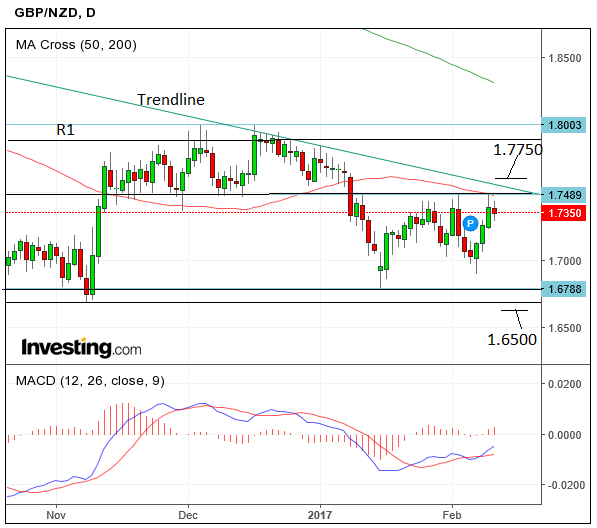Outlook for the GBP/NZD Rate for the Coming Week

GBP/NZD is trading in a range roughly between 1.68/70 and 1.75 and may also be tapering to a point within that range as its constituent waves narrow.
There is no clear bias either way from the charts and we await further confirmation for clarity on which way the pair will break.
A move clearly above the range highs and the trendline, confirmed by a break above 1.7550 would see the pair move into open country and higher to a target at 1.7750.
Alternatively, a move below the base of the range, with confirmation coming from a break below 1.6600 would probably lead to an extension down to the round number at 1.6500.
Data, Events for the New Zealand Dollar
It is a thin week on the data front for the New Zealand Dollar, with the highlights coming on Thursday, at 20.35 GMT, in the form of NZ Business PMI and then slightly later at 20.45 with Core Retail Sales and Retail Sales (qoq) in Q4, the latter of which is forecast to come out at 1.0% from 0.9% previously.
The kiwi continues to trade against a backdrop of lower inflation forecasts following the downward revision from the Reserve Bank of New Zealand (RBNZ) at their recent rate meeting.
Although this came as a surprise given the relative resilience of the New Zealand economy, the NZD's reaction chimes with forecasts that there is a 70% probability the Kiwi will weaken in Q1 based on research by RBC Capital markets into commodity currency cycles.
Data, Events this week for the Pound
Inflation data for January is out at 9.30 on Tuesday, February 12, with analysts estimating a rise of 1.9% from the previous 1.6%.
The Bank of England will only raise interest rates should inflation be seen to be rising faster than they expected, and if markets see the prospect of higher interest rates on the horizon they will start bidding the Pound higher.
However, a rise in inflation is forecast due to the impact of the weaker Pound which has increased the cost of imports.
However, inflation is rising across the world at present as oil prices recover from record lows.
Therefore the Bank of England will look through any rise in inflation should they be due to these factors.
That is why markets will be watching instead is the core inflation rate - that element of the inflation picture that is due to economic growth, and wage rises in particular.
Therefore, what markets will instead be looking at is the core headline figure which is forecast to rise by 1.8% year-on-year in January, up from 1.6% in December.
Should the core level rise faster than expected then markets might take a bet that the Bank will be looking to raise interest rates sooner than they indicated in their February Inflation Report.
We heard last week that outgoing MPC member Kristin Forbes believes that an interest rate is actually warranted owing to the resillience of the UK economy.
If inflation beats expectations then perhaps other members of the MPC will share Forbes' view.
With wage data being so important then, expect market focus to turn to jobs and earnings data due out on Wednesday.
Average earnings will be in focus with 2.8% growth in wages being forecast. If this beats expectation then Sterling could be bid higher.
Watch for the unemployment rate to stay unchanged at 4.8%.
The Bank of England believes the economy's full employment threshold lies at 4.5%, the sooner this level is reached the sooner rates will likely rise.






